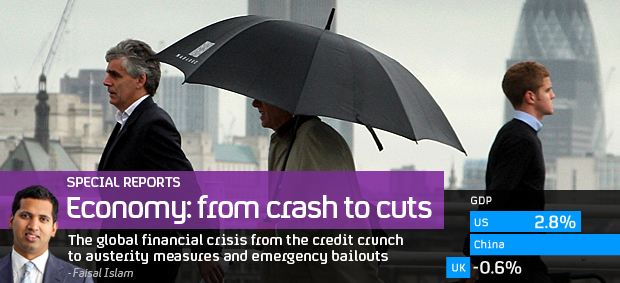UK growth at 0.5 per cent – but is this a 2011 peak?
The UK economy grew by 0.5 per cent between July and September. However, an economist warns Channel 4 News there are still “reasons to be nervous”.
The UK’s economic recovery hopes could be boosted by official figures which show that the pace of growth accelerated faster than expected in the third quarter of 2011.
GDP increased by 0.5 per cent in the three months to the end of September, representing an improvement on the 0.1 per cent rise in the previous quarter, the Office for National Statistics revealed.
Economists had predicted a figure of between 0.3 per cent and 0.4 per cent.
The figures will help ease some of the fears about the strength of the recovery after the economy effectively flatlined over the previous nine months.
He’s undershooting even the more pessimistic forecasts from the IMF and OECD. Ed Balls, Shadow Chancellor
But Shadow Chancellor Ed Balls told Channel 4 News it was now time for Chancellor George Osborne to change his deficit reduction plan. “He’s undershooting even the more pessimistic forecasts from the IMF and OECD, and they said if the economy undershoots, if we keep dragging along the bottom, the government should change course and move towards a more balanced plan. I think now the case for George Osborne to change course is completely compelling.”
Below average
Growth is still below its long-term average and economists warn the latest figures were artificially inflated as GDP played catch-up after the previous quarter, which was hit by one-off factors such as the royal wedding.
Charles Davis, managing economist at the Centre for Economics and Business Research (CEBR), told Channel 4 News the figures were a “positive surprise” – but there are still lots of concerns.
“The figures are a positive surprise, which the UK economy has not been particularly used to seeing of late. However there are reasons to be nervous,” he said.
The figures are a positive surprise, which the UK economy has not been particularly used to seeing of late. However there are reasons to be nervous. Charles Davis, managing economist, CEBR
These ONS figures are estimates, rather than the full figures, because the organisation does not have all the data it needs yet. It then revises its estimate to a final figure.
This is an issue, Mr Davis said, as the situation worsened considerably towards the second half of the quarter amid the turmoil in the eurozone.
He told Channel 4 News: “They do a very good job based on the estimates they have got. But it’s common sense here – they are more likely to have more data from the first and second months than the third – and we know the third month was when things started to get worse.
“August and September were terrible on the equity markets, business confidence tailed off. Moreover one of the drivers was growth in business services and the financial sector, which seems odd when that sector had a tough Q3.
“There are reasons to be nervous – and when you look at the other stuff, for example that the manufacturing sector grew by only 0.2 per cent – this is by no means a robust recovery.”
He said the key concern was what would happen in the next quarter.
“While today’s news on GDP is a welcome positive surprise, unfortunately backward looking data are always less relevant than the latest forward looking indicators. So, while Q3 looks better than expected for now, the real worry is the UK’s performance in Q4 – which is presumably why the Bank of England felt compelled to inject an additional £75 billion into the economy in October.”
